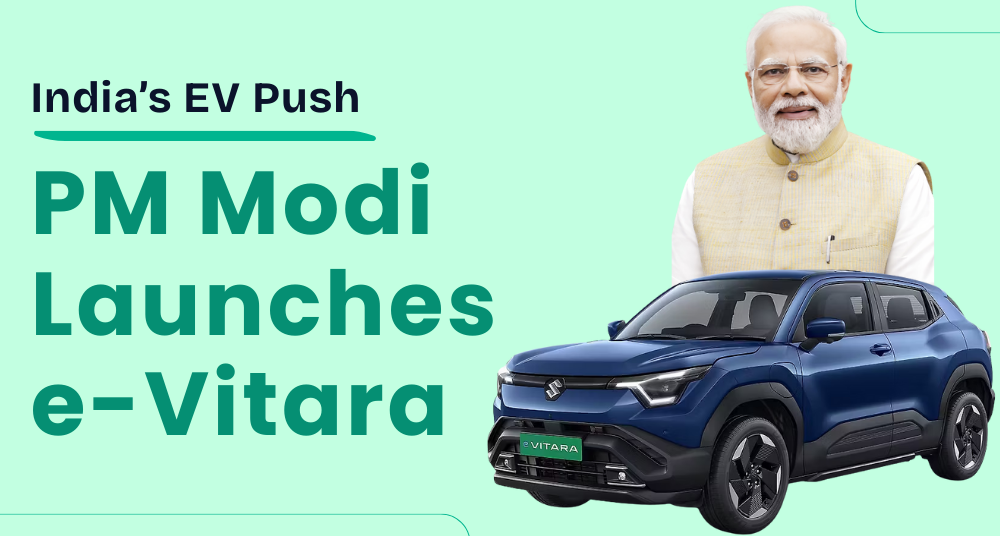On August 26, 2025, Prime Minister Narendra Modi heralded a new era for Indian manufacturing as he flagged off Maruti Suzuki’s first Battery-Electric Vehicle, the e-Vitara, at the Hansalpur plant in Gujarat. This “Made in India” electric SUV is not just a product—it’s a symbol of growing EV ambitions, global confidence in Indian capabilities, and the power of a bolstered “Make in India” ecosystem.
The e-Vitara is slated for export to over 100 countries, including Japan and European markets, positioning India as a global EV hub. Shares of Maruti Suzuki surged following the launch, signaling investor optimism in India’s electric future.
This blog dives deep into the implications of this milestone for India’s EV sector—examining strategic trends, manufacturing growth, infrastructure, global competitiveness, and how Indians perceive this shift as the future of mobility.
A Defining Milestone for India’s EV Ambitions
The launch of the e-Vitara marks a significant inflection point in India’s race toward clean mobility. Built on the advanced Heartect-e platform and produced at the newly established lithium-ion battery facility in Gujarat, the vehicle embodies local capability across the entire EV value chain—from cell production to final assembly.
PM Modi’s emphasis on “swadeshi” as a life mantra, coupled with the strong focus on battery localization, speaks to a bold vision of self-reliance in clean energy technologies. With six semiconductor plants under development and the National Critical Mineral Mission rolling out over 1,200 exploration campaigns, India’s policymaking is taking aim at strategic autonomy in EV and semiconductor supply chain.
This event isn’t just a product launch—it represents India’s readiness to compete on the global stage with fully homegrown EVs.
The e-Vitara: Specs and Export Ambitions
A true showcase of India-built automotive prowess, the Maruti e-Vitara is the first global strategic BEV from Suzuki—unveiled previously at Milan’s Auto Expo in late 2024—and brought into production by spring 2025.
Key specs include:
- Two battery options: 49 kWh and 61 kWh LFP packs
- Range: Up to 426 km (WLTP basis for 61 kWh)
- Drive tractions: 2WD and AllGrip-e AWD system
- Built on Heartect-e EV platform with e-Axle tech
- Production capacity: Plant targets ~70,000 units in FY26; export-first strategy to over 100 countries.
Production has already commenced at the Hansalpur facility—a key node featuring its own rail siding, enabling seamless logistics and exports directly to ports.
Industrial Vision & Global Outreach
This launch underscores India’s central role in Suzuki’s global EV strategy—transforming into a manufacturing powerhouse not just for domestic needs, but for global export markets from Europe to Japan.
Moreover, the joint venture TDS Lithium-Ion factory (Toshiba, Denso, Suzuki) now begins localized production of critical battery components—propelling India toward over 80% domestic value in EV batteries.
With the scale-up of semiconductor plants and the National Critical Mineral Mission, the country is gearing up for a manufacturing transformation—one that aligns with its demographic strengths and policy reforms under the “Mission Manufacturing” and “Make in India” packs.
Investors are clearly bullish—Maruti shares reached a 52-week high, affirming confidence in the company’s EV strategy.
India’s EV Industry: Momentum, Challenges & the Road Ahead
Despite the fanfare, India’s EV penetration remains modest—currently around 2% of total vehicle sales. Challenges like charging infrastructure gaps, range anxiety, and battery costs persist, tempering consumer adoption rates.
Still, the e-Vitara launch signals both manufacturing readiness and a change in mindset. India is now positioning itself not merely as a consumption market but a competitive EV production hub—continuously reducing reliance on imports and securing critical minerals.
However, India must address a few key hurdles:
- Supply chain vulnerabilities—as seen in earlier delays due to rare-earth shortages and regulatory hurdles.
- Market infrastructure—scaling up charging stations and logistics support to match rising EV volumes.
- Consumer shift—public awareness and financial incentives must match supply-side growth.
Strategically, Maruti Suzuki plans at least four EV models by 2030, targeting 50% market share in India’s EV segment—hinting at a broader ecosystem evolution .
With battery localization, mining exploration, and stronger regulations, India is shaping a holistic EV ecosystem. The launch of e-Vitara is a catalyst—kickstarting manufacturing advancement, inspiring other OEMs, and elevating India’s image in global clean mobility.
How India Sees the e-Vitara: A Symbol of Future EV Leadership
For many Indians, the e-Vitara isn’t just an electric SUV; it’s a signal of a cleaner, more ambitious future. Here’s why it’s so symbolic:
- National Pride: A fully built SUV going to Europe & Japan boosts ‘Vocal for Local’ and echoes PM Modi’s “swadeshi” vision.
- Job Creation & Growth: Manufacturing and infrastructure investments—backed with ₹5,400 crore in adjacent projects—translate into employment and regional development.
- Technological Leap: It accelerates India’s transition from ICE dominance to EV-ready ecosystems—broadening consumer choice and setting sustainability benchmarks.
- EV Normalization: A mainstream brand diving into exports-normalizes EVs, making them less niche and more everyday.
- Global Validation: India’s capabilities are validated as nations import Indian-made EVs—a vote of confidence in quality and competitiveness.
In short, the e-Vitara is a dual emblem of self-reliance and global capability—a model of how India perceives its future intertwined with clean technology and industrial excellence.
Future Outlook: From e-Vitara to EV Dominance
Maruti Suzuki’s launch of the e-Vitara is a launching point—not the endpoint. Here’s what lies ahead:
- Diversifying EV Portfolio: With at least four EVs planned by 2030, Maruti is tackling multiple segments—from compact EVs like Fronx to potential MPVs—aiming for broader market relevance.
- Enhancing Infrastructure: Charging network expansion and mineral supply mapping are underway, promising smoother EV adoption paths.
- Policy Backing: Continued FAME incentives, mineral exploration, and industrial zones will help secure India’s EV supply chain.
- Consumer Confidence: As first-generation EVs succeed, trust and desirability rise—prompting mass adoption.
- Global Market Integration: India’s export volume will grow, requiring scale-up in logistics and technology. The Hansalpur plant’s railway-siding innovation is an example of infrastructure readiness.
If India can sustain this momentum—scaling production, ensuring supply resilience, and fostering consumer trust—it can transition from EV aspirant to EVsupplier, fulfilling both economic and environmental ambitions.
Conclusion
The flagging-off of the Maruti Suzuki e-Vitara by PM Modi is more than an auto-industry milestone—it’s a milestone for India’s EV narrative. From localizing battery production to targeting exports to over 100 countries, this moment marks India’s emergence as a serious contender in global electric mobility.
Despite hurdles—like infrastructure gaps and supply chain constraints—this venture epitomizes a bold shift. India views this as the start of an EV era based on self-reliance, technological innovation, and global outreach. The e-Vitara is not just a vehicle; it’s a vehicle for change.
As more models, infrastructure, and policies fall into place, India moves closer to its vision: a clean, competitive, and globally connected EV ecosystem. The road ahead is electrified—and powered by India’s ambitions.






What do you think?
It is nice to know your opinion. Leave a comment.